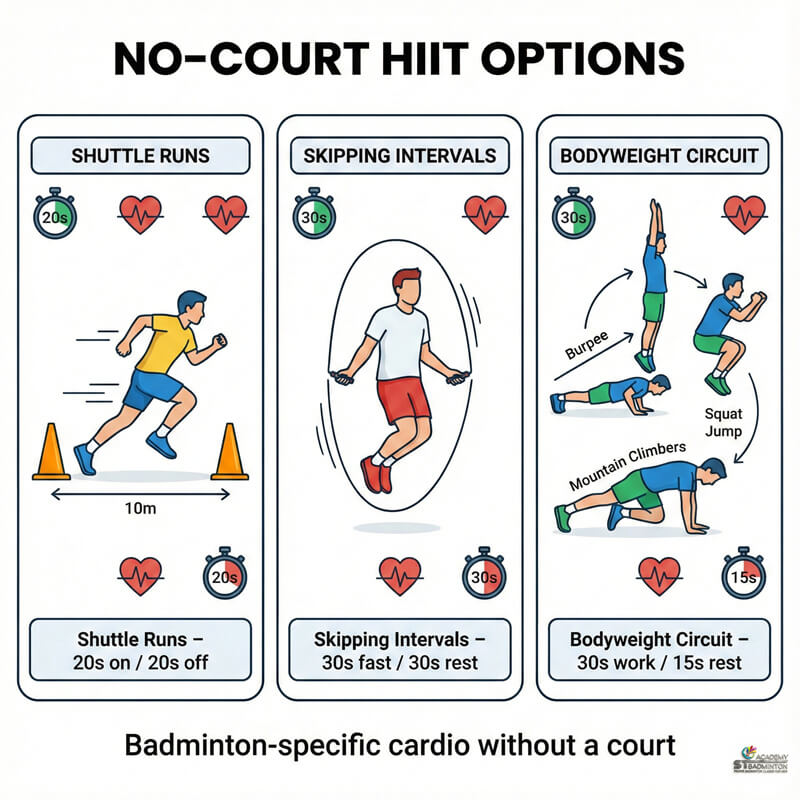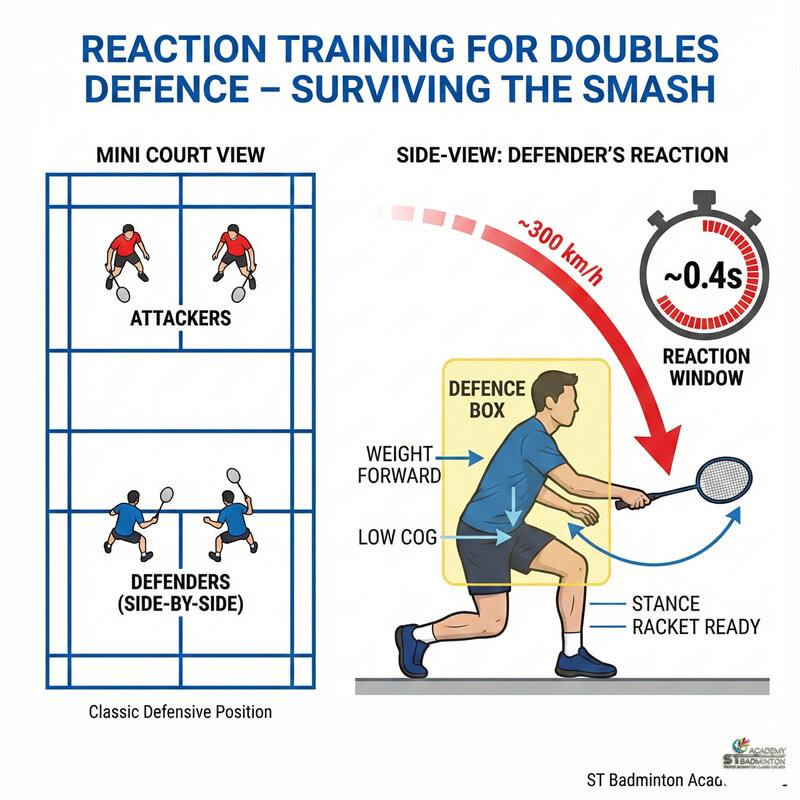What Role Does Flexibility Play In Badminton Training? (Malaysia & Singapore)
As a badminton coach in Malaysia and Singapore, I often see players ignore stretching until they get injured. Once we add simple, consistent flexibility work into their weekly plan, their movement feels lighter, their recovery is smoother, and many small pains slowly reduce. This guide helps families and players in Setapak, Wangsa Maju, Kepong, Cheras and surrounding areas understand why flexibility and mobility matter for badminton performance, injury prevention and long term progress.
A certified badminton coach explains how better range of motion supports footwork, lunges, overhead shots and recovery for kids, teens and adults across Kuala Lumpur and Singapore.
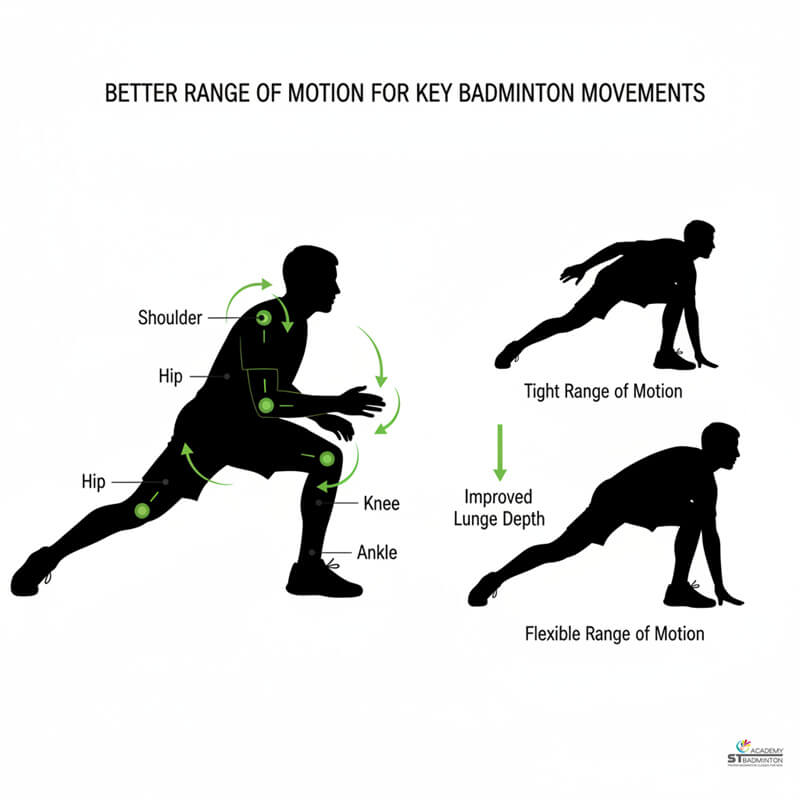
Key Benefit #1
Better Range of Motion for Key Badminton Movements
Flexibility in badminton means how far your joints can move comfortably during lunges, overhead smashes and quick direction changes. Good shoulder flexibility allows deeper backswing for powerful clears and smashes. Better hip and hamstring flexibility helps players in Malaysia and Singapore reach lower lunges at the net and back corners without straining their knees or groin.
When players from Setapak, Wangsa Maju and Cheras train with our certified coach at ST Badminton Academy, we include simple mobility drills before each session. This prepares shoulders, hips and ankles for the demands of badminton movement. Over weeks and months, improved range of motion makes every lunge feel smoother, every overhead shot more relaxed, and recovery steps faster.
Flexibility is not only about touching your toes. It directly supports the technical movements that win rallies in real matches.
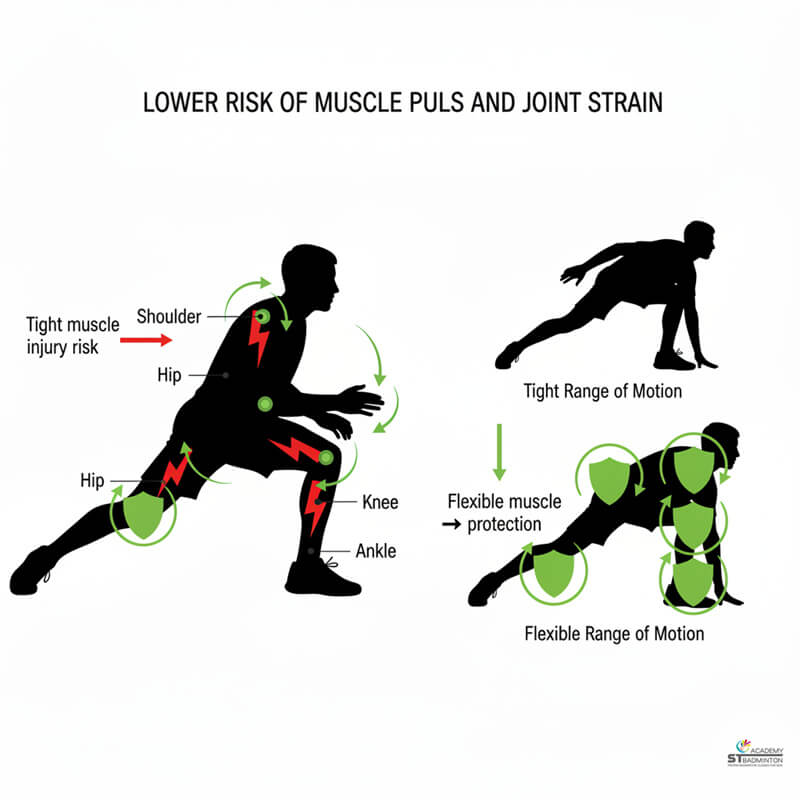
Key Benefit #2
Lower Risk of Muscle Pulls and Joint Strain
Many badminton injuries in Kuala Lumpur and Singapore happen when tight muscles cannot handle sudden movements during matches. Common problems include hamstring pulls from deep lunges, shoulder strain from overhead smashes, and ankle sprains from poor landing balance. Consistent flexibility training helps reduce these risks by allowing muscles and joints to move through their full range safely.
Players from Selayang, Kepong and Ampang who add simple stretching routines after training often notice fewer small aches and faster recovery between sessions. When muscles are more flexible, they can absorb force better during sudden stops and direction changes. This protective effect is especially important for school team players and working adults in Malaysia who cannot afford to miss training due to preventable injuries.
Our coaching team at ST Badminton Academy teaches age appropriate stretching that protects young players without forcing their joints into uncomfortable positions. The goal is steady improvement in range of motion over months, not extreme flexibility gained too quickly.
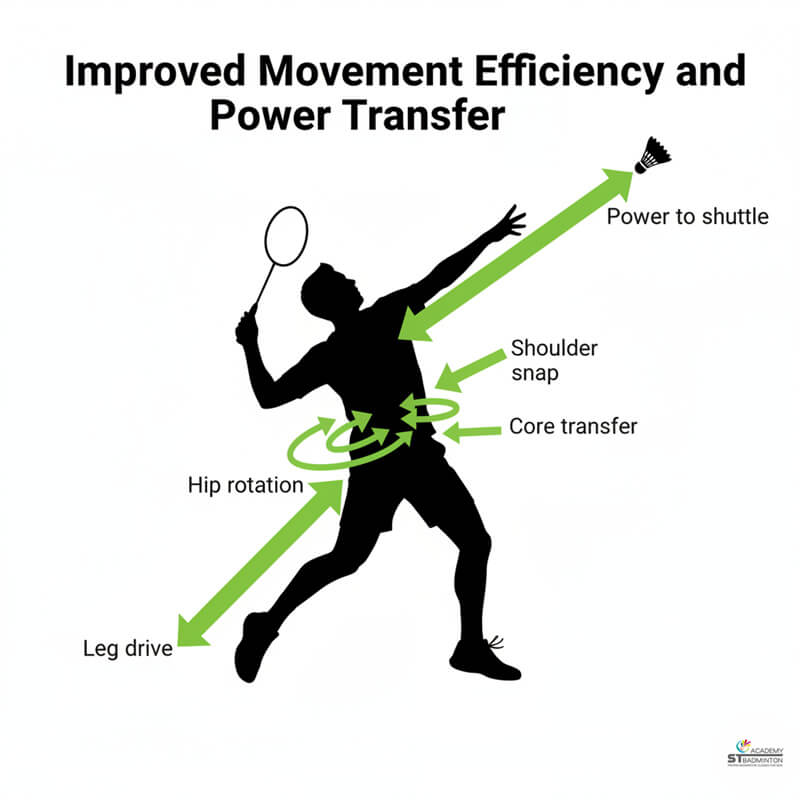
Key Benefit #3
Improved Movement Efficiency and Power Transfer
Flexibility in badminton is not only about being soft or stretchy. Proper shoulder mobility allows a full backswing which helps store energy before releasing it during smashes and clears. When joints can move freely through their natural range, less energy is wasted fighting against tight muscles and more power reaches the shuttlecock.
Players from Sentul, Gombak and Cheras who work on hip flexibility often find their lunges become more stable and recovery steps feel lighter. Good ankle mobility supports better balance and push off power during quick direction changes. All of this makes badminton movement more efficient, especially during long matches in hot, humid conditions across Malaysia and Singapore.
Our certified coach at ST Badminton Academy emphasises that flexibility must be paired with strength and good technique. Over stretching without control is not helpful. The goal is balanced mobility that supports powerful, relaxed movements on court.
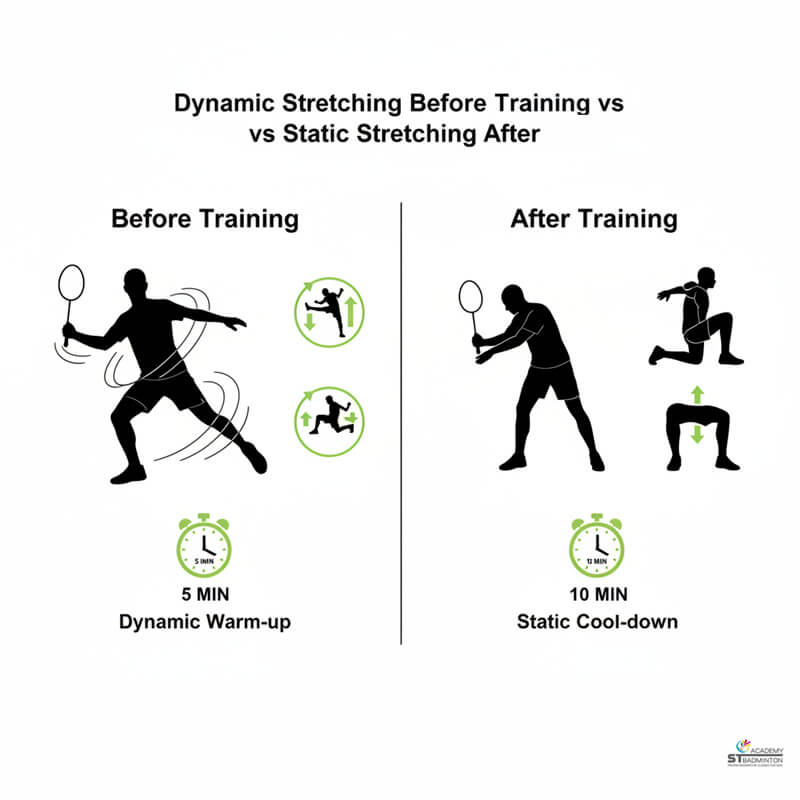
Important Distinction
Dynamic Stretching Before Training vs Static Stretching After
Many players in Malaysia and Singapore are confused about when to stretch and which type of stretching to use. Before badminton training or matches, focus on dynamic stretching and mobility drills such as leg swings, arm circles, walking lunges and hip openers. These movements prepare muscles for action and activate the nervous system without reducing power.
After training or during separate cool down sessions, use gentle static stretches where you hold each position for 20 to 30 seconds. This is when you target specific tight areas like hamstrings, hip flexors, shoulders and calves. Keep breathing calm and never force joints into painful positions.
Players from Wangsa Maju, Ampang and Singapore areas like Jurong or Clementi who follow this pattern see better warm up quality and steady flexibility gains over time. Our coaching team helps families understand that dynamic stretching is for activation while static stretching is for long term range of motion improvement.
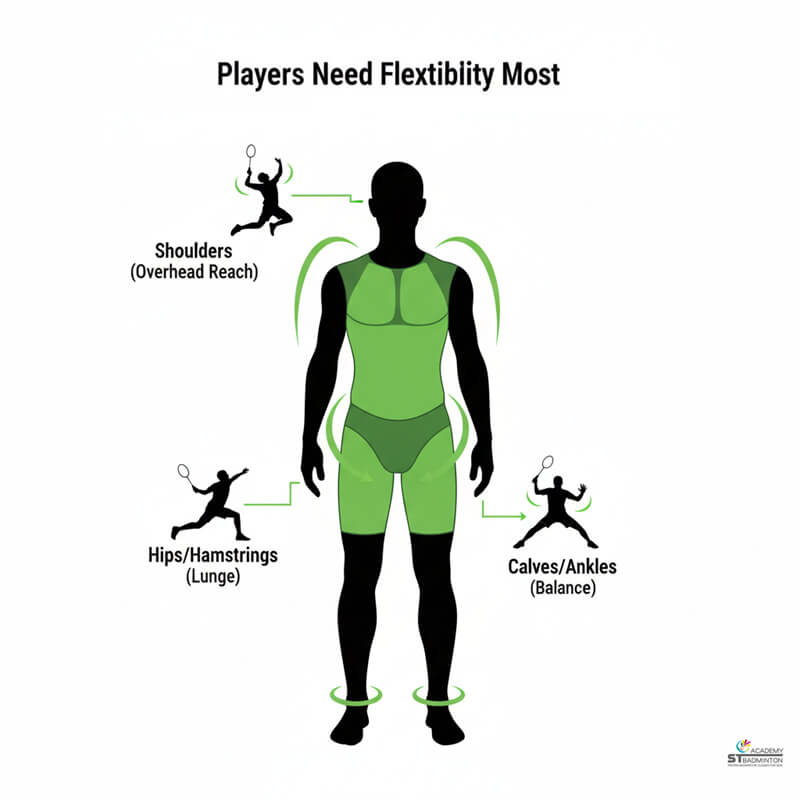
Common Tight Areas
Where Badminton Players Need Flexibility Most
Most badminton players in Kuala Lumpur and Singapore develop tightness in predictable areas. Shoulders and chest become stiff from repeated overhead strokes like smashes, clears and drops. Hip flexors and hamstrings tighten from constant lunging and split steps. Calves and ankles lose mobility from jumping and quick direction changes on court.
This stiffness can limit lunge depth, reduce reach at the net, make recovery slower and increase stress on knees and lower back. Working adults from Setapak, Petaling Jaya, Puchong and Singapore office areas often feel especially tight after sitting at desks all day before training. Kids and teens may have natural flexibility but still need to maintain good mobility as they grow and train more intensely.
Our certified coach at ST Badminton Academy teaches simple stretches that target these common problem areas. The focus is on shoulder and thoracic mobility for overhead shots, hip flexor and hamstring stretches for lunges, calf and ankle stretches for balance and push off, and basic wrist and forearm stretches for racket control.
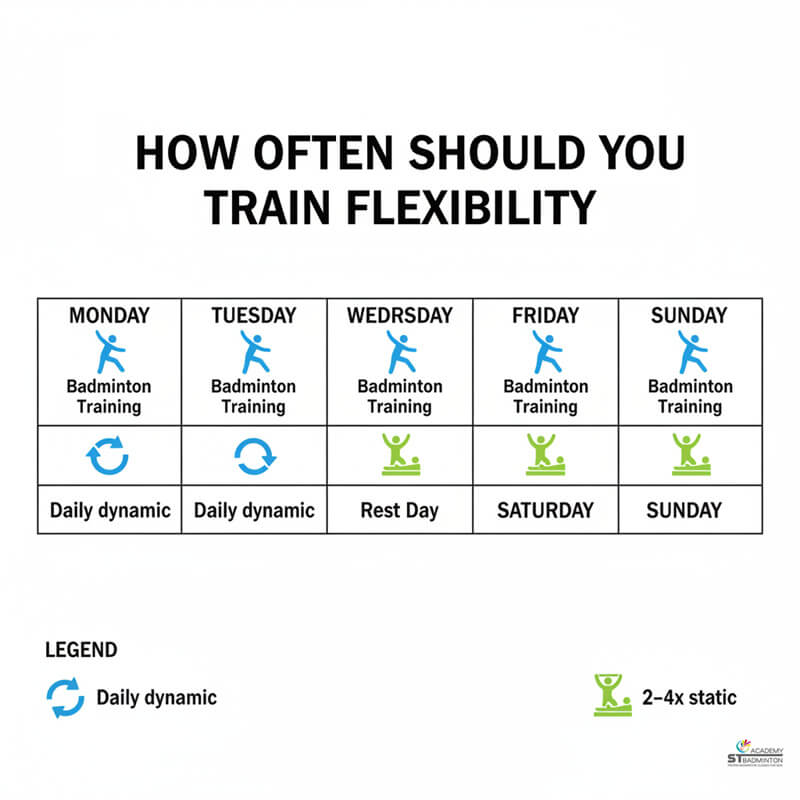
Practical Advice
How Often Should You Train Flexibility for Badminton in Malaysia?
Realistic flexibility training for badminton players in Kuala Lumpur and Singapore includes a few minutes of dynamic mobility work before every training session or match. This prepares the body safely and activates key muscle groups needed for footwork and strokes.
Add 10 to 15 minutes of gentle static stretching two to four times per week, either after training sessions or on separate recovery days. Focus on the areas that feel tight such as shoulders, hips, hamstrings and calves. Working adults in Kepong, Cheras, Subang Jaya or Singapore office areas can include brief desk break stretches during the day to reduce stiffness before evening badminton.
Small, regular stretching is more effective than one long session once a month. Kids aged 4 to 12 naturally have good flexibility and only need short, playful mobility work and post training stretches. Teens and school team players benefit from more structured routines, especially during growth spurts. Our coaching team at ST Badminton Academy helps families plan age appropriate flexibility work that fits smoothly into weekly training schedules.
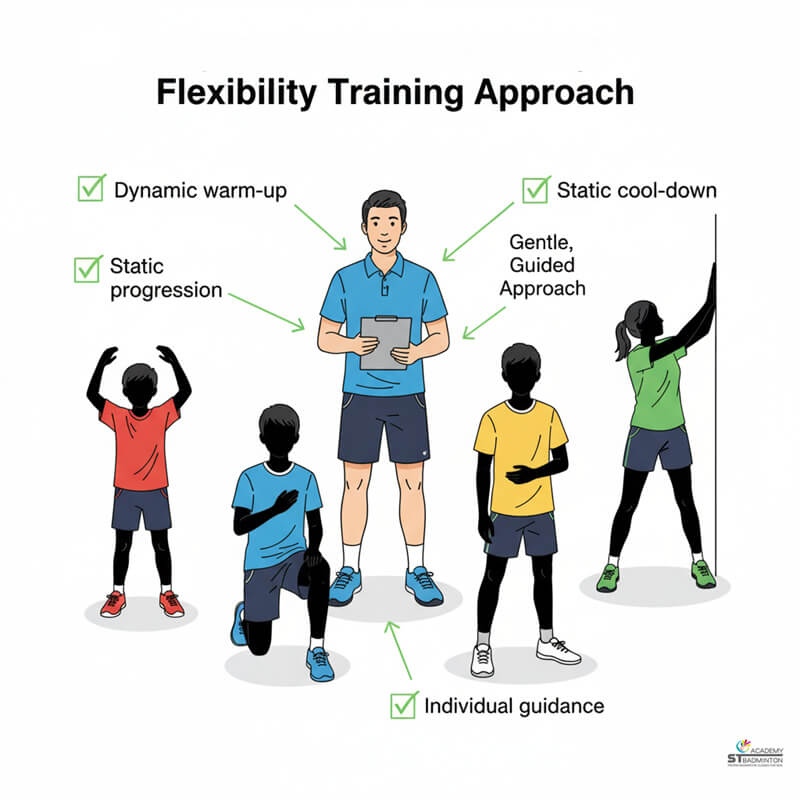
Why Choose Us
ST Badminton Academy Flexibility Training Approach
At ST Badminton Academy in Kuala Lumpur, we treat flexibility as an essential part of complete badminton training, not an optional extra. Our certified coach includes age appropriate mobility drills before every session and guides safe stretching routines after training for kids aged 4 and above, teens and adults.
We teach families in Setapak, Wangsa Maju, Selayang and surrounding areas that good flexibility work is simple, consistent and protects all the technical skills and fitness training they invest time in. Players learn which stretches support their specific needs, when to use dynamic versus static stretching, and how to avoid forcing joints into painful positions.
Working adults from Cheras, Ampang, Petaling Jaya and Singapore areas like Bishan, Ang Mo Kio or Tampines appreciate guidance on fitting flexibility work around busy schedules. Contact us to learn how proper mobility and stretching training can improve your badminton performance, reduce injury risk and support long term progress across Malaysia and Singapore.
FAQs: What Role Does Flexibility Play In Badminton Training?
Here are answers to common questions about flexibility and stretching for badminton players in Malaysia and Singapore.
How often should I stretch for badminton in Kuala Lumpur and Singapore?
Do a few minutes of dynamic stretching before every training session or match. Add 10 to 15 minutes of gentle static stretching two to four times per week after training or on rest days. Players in Setapak, Wangsa Maju and Singapore areas see steady flexibility improvement with this pattern. Our certified coach at ST Badminton Academy helps families plan age appropriate stretching routines that fit weekly schedules.
Is stretching really necessary for kids who play badminton in Malaysia?
Yes, but kids aged 4 to 12 need gentle, age appropriate stretching that focuses on good movement patterns rather than extreme flexibility. Short playful mobility drills before training and simple post session stretches are enough. Kids in Kuala Lumpur and Singapore who follow consistent stretching habits develop better body awareness and injury resistance as they grow. Our coaching team teaches safe stretching that protects young players without forcing joints.
What is the difference between flexibility and mobility in badminton training?
Flexibility means how far a joint can move passively. Mobility means flexibility plus control and strength through that range. Badminton players in Selayang, Kepong and Ampang need both. Good shoulder flexibility allows deeper backswing while shoulder mobility means you can control that range during powerful smashes. Our certified coach at ST Badminton Academy helps players develop balanced mobility that supports technical movements on court.
Should I stretch before or after badminton training in Singapore?
Use dynamic stretching like leg swings and arm circles before training to activate muscles without reducing power. Save gentle static stretches for after training when muscles are warm. This timing helps players in Jurong, Clementi and Bishan get better warm up quality and steady long term flexibility gains. Our coaching team teaches simple routines that follow this pattern safely for kids, teens and adults.
Can stretching help reduce badminton injuries in Kuala Lumpur?
Yes, consistent flexibility training helps reduce muscle pulls, joint strain and overuse injuries. Good range of motion allows safer movement during deep lunges, quick direction changes and overhead shots. Players from Cheras, Sentul and Gombak who add regular stretching to their training routine often experience fewer small aches and faster recovery. However, flexibility must be paired with proper technique and gradual training progression for best injury prevention results.
Which body parts need most flexibility for badminton in Malaysia and Singapore?
Most badminton players need shoulder mobility for overhead shots, hip and hamstring flexibility for deep lunges, and ankle mobility for balance and push off. Working adults in Petaling Jaya, Subang Jaya and Puchong often have especially tight hips and shoulders from desk work. Our certified coach at ST Badminton Academy teaches stretches that target these common problem areas safely for all ages and levels.
Is it safe for children to do partner stretching in badminton training?
Heavy partner stretching is not recommended for young children in Malaysia and Singapore because kids cannot accurately control force and may push joints too far. Kids aged 4 to 12 should focus on gentle self-stretching and simple mobility drills under coach supervision. ST Badminton Academy teaches age appropriate flexibility work that protects young players while building good range of motion safely over time without aggressive forcing.
Does flexibility training improve badminton smash power in Singapore?
Yes, proper shoulder flexibility allows a fuller backswing which helps store energy before release during smashes. However, flexibility alone is not enough. Players in Singapore areas like Bishan, Ang Mo Kio and Yishun need flexibility paired with strength and correct technique for powerful smashes. Our coaching team emphasises balanced training where mobility supports technical movements rather than replacing proper skill development on court.
When should I seek guidance on flexibility training for badminton in Malaysia?
Talk to a certified badminton coach if you feel pain during stretching, have existing injuries or are unsure which stretches match your level. Players in Kuala Lumpur and Singapore with medical conditions should consult healthcare professionals before starting flexibility programmes. Our coaching team at ST Badminton Academy in Setapak helps families design safe, age appropriate stretching routines that support badminton training without risking injury.
Flexibility Training in Action
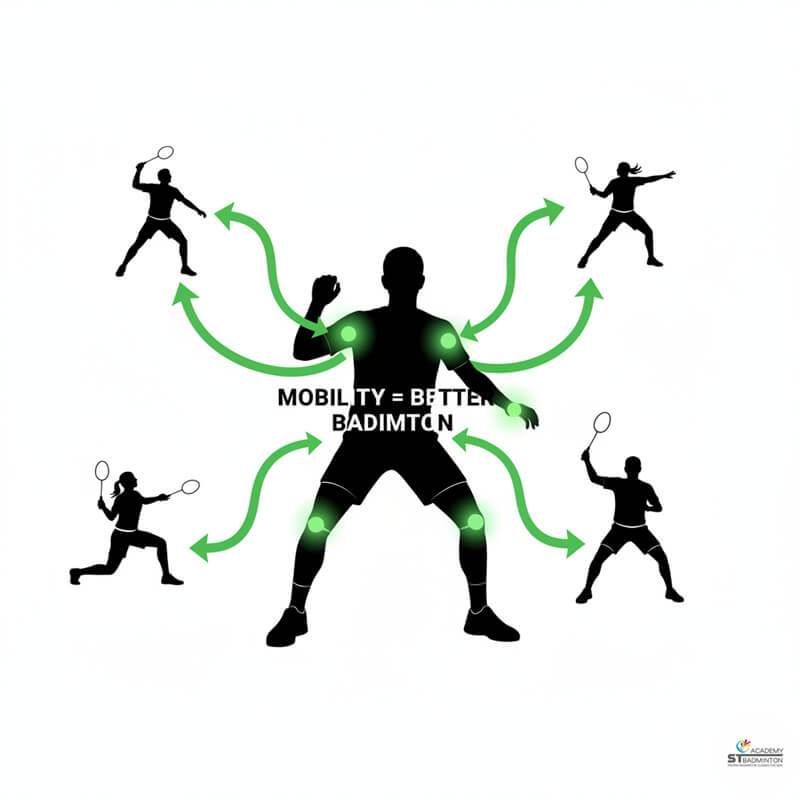
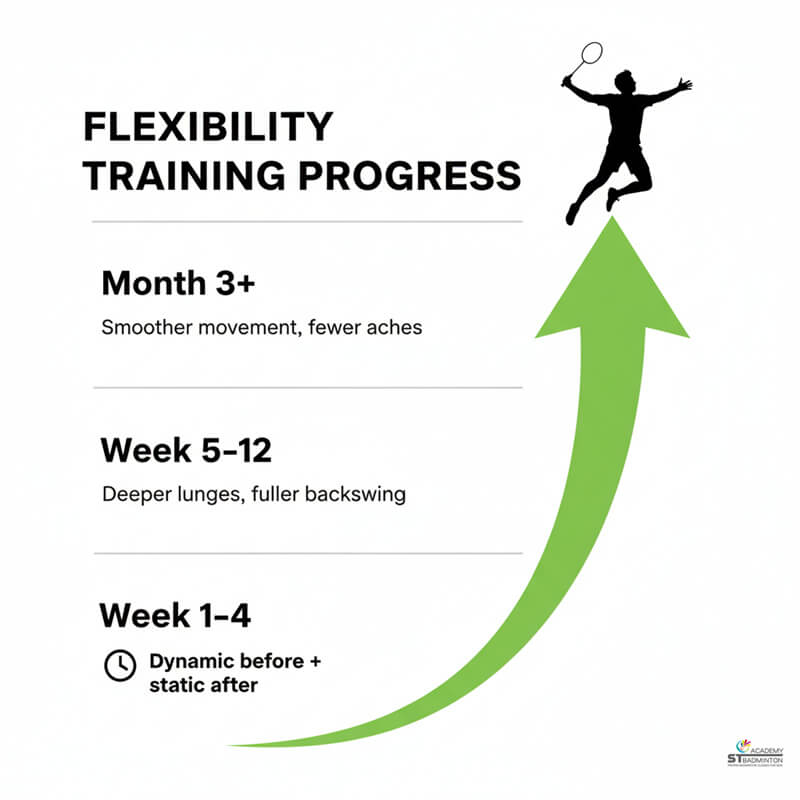
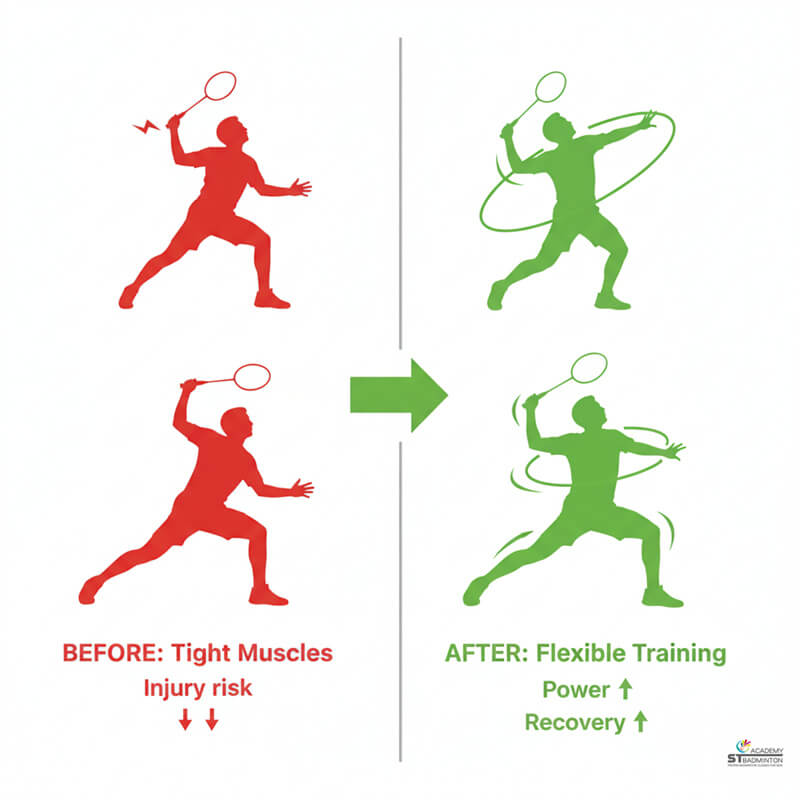

Benefits of Consistent Flexibility Training
Adding simple, regular flexibility and mobility work helps badminton players in Malaysia and Singapore move more efficiently, recover faster and reduce injury risk. Our certified coach teaches age appropriate stretching routines that support all the technical skills and fitness training players invest time in.
| Training Aspect | Ignoring Flexibility Work | Consistent Safe Stretching SMART |
|---|---|---|
| Lunge Depth | Tight hips and hamstrings limit how low you can reach. Miss many shots at net and back corners. | Good hip flexibility allows deeper lunges with better balance. Reach more shots safely without knee strain. |
| Overhead Power | Stiff shoulders block full backswing. Reduced smash and clear power with higher injury risk. | Shoulder mobility enables complete backswing and follow through. Better power transfer with relaxed movement. |
| Injury Risk | Tight muscles cannot handle sudden movements. Common hamstring pulls, shoulder strain and ankle sprains. | Flexible muscles absorb force better during quick changes. Lower risk of muscle pulls and joint strain. |
| Recovery Speed | Stiff body fights against every movement. Constant small aches and slow recovery between training sessions. | Better range of motion makes recovery steps lighter. Faster bounce back after matches in hot humid conditions. |
| Movement Quality | Restricted joints waste energy fighting tight muscles. Movement looks and feels heavy on court. | Smooth mobility allows efficient footwork and strokes. Less energy wasted means better endurance during matches. |
| Kids Development | Natural flexibility lost over time without maintenance. Poor movement patterns develop early. | Gentle consistent stretching maintains good range of motion. Kids learn healthy habits for long term sport participation. |
| Adults Progress | Office workers get increasingly stiff. Training feels harder and injuries happen more often. | Regular stretching reduces desk job stiffness. Working adults in KL and Singapore improve comfort and performance. |
Safe Flexibility Training for Badminton in Kuala Lumpur and Singapore
This guide helps players and parents in Malaysia and Singapore understand why flexibility matters for badminton and how to train it safely. ST Badminton Academy includes age appropriate mobility and stretching work for kids aged 4 and above, teens and working adults in Setapak, Wangsa Maju, Selayang, Kepong, Cheras and surrounding areas. If you want guidance on fitting simple, effective flexibility training into your weekly badminton routine, contact us to learn about coaching that protects your body while supporting long term improvement.

